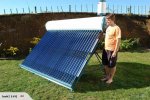mark.duyvesteyn
Member
Im am wanting to build a sun tracker for a large water solar panel. Im not too sure on the efficency gains from having it pointed it directly at the sun all the time, but i mainly want to do it cause i can, and it would be cool.
I was thing about mounting it at a fixed angle on a pivoting washing line base, and using a motor + worm drive to turn it with the sun.
now, how to track the sun. Timer based (like a clock), or light intensity based? Any other smart ways of doing it? a scanning servo and one LDR that looks for the brightest point?...
thanks
I was thing about mounting it at a fixed angle on a pivoting washing line base, and using a motor + worm drive to turn it with the sun.
now, how to track the sun. Timer based (like a clock), or light intensity based? Any other smart ways of doing it? a scanning servo and one LDR that looks for the brightest point?...
thanks

